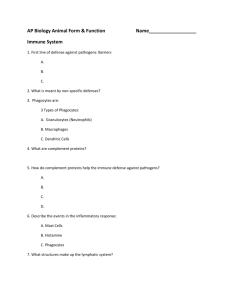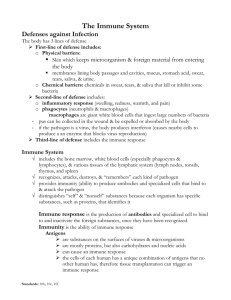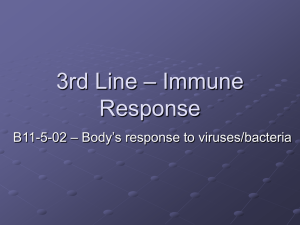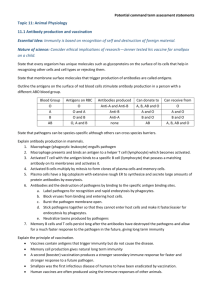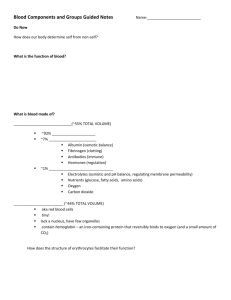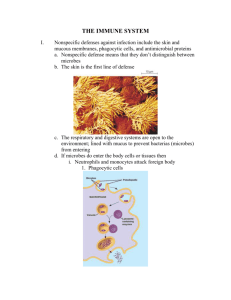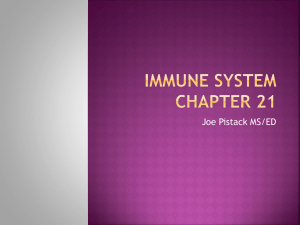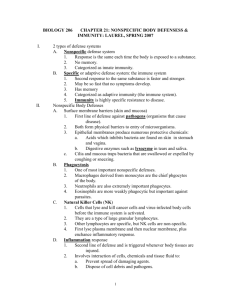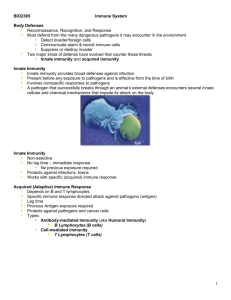Notes on the Immune System
advertisement
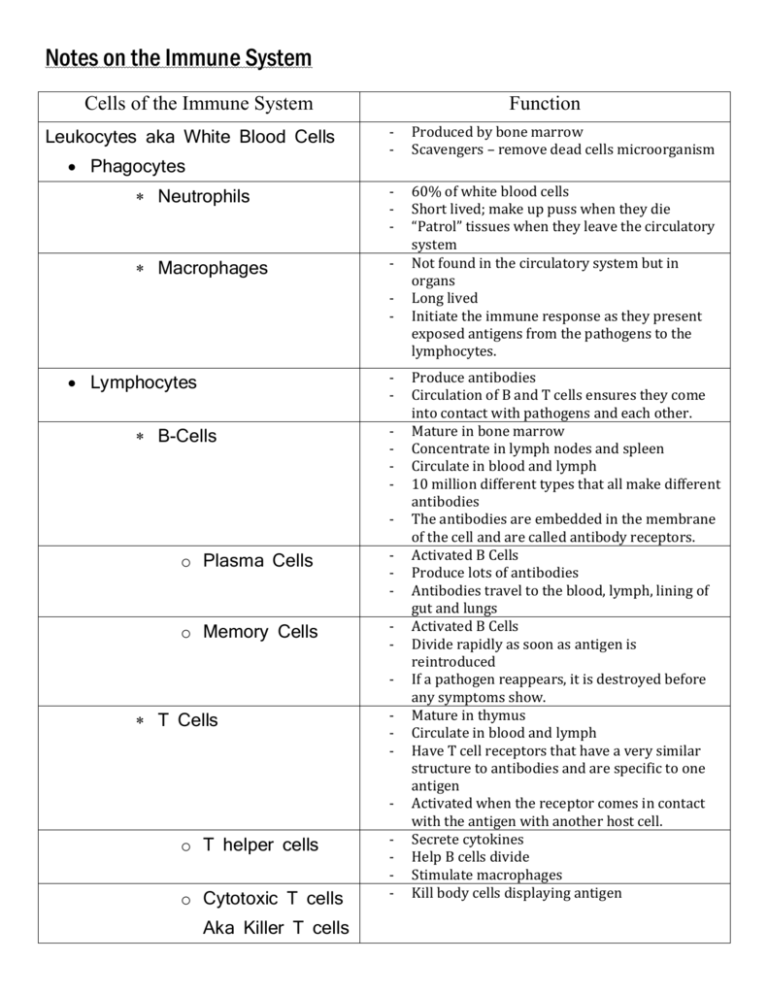
Notes on the Immune System Cells of the Immune System Function Leukocytes aka White Blood Cells - Produced by bone marrow Scavengers – remove dead cells microorganism Neutrophils - Macrophages - 60% of white blood cells Short lived; make up puss when they die “Patrol” tissues when they leave the circulatory system Not found in the circulatory system but in organs Long lived Initiate the immune response as they present exposed antigens from the pathogens to the lymphocytes. Phagocytes - Lymphocytes - B-Cells - o Plasma Cells - o Memory Cells - T Cells - o T helper cells o Cytotoxic T cells Aka Killer T cells - Produce antibodies Circulation of B and T cells ensures they come into contact with pathogens and each other. Mature in bone marrow Concentrate in lymph nodes and spleen Circulate in blood and lymph 10 million different types that all make different antibodies The antibodies are embedded in the membrane of the cell and are called antibody receptors. Activated B Cells Produce lots of antibodies Antibodies travel to the blood, lymph, lining of gut and lungs Activated B Cells Divide rapidly as soon as antigen is reintroduced If a pathogen reappears, it is destroyed before any symptoms show. Mature in thymus Circulate in blood and lymph Have T cell receptors that have a very similar structure to antibodies and are specific to one antigen Activated when the receptor comes in contact with the antigen with another host cell. Secrete cytokines Help B cells divide Stimulate macrophages Kill body cells displaying antigen o Memory T cells - Remain in body Phagocytosis: When cells are under attach they release histamine which triggers an immune response (inflammation, eg. Allergies). When the histamine is combined with chemicals secreted by pathogens, neutrophils are attracted to the infection site. On the surface of pathogens there are antibodies and neutrophils have antibody receptors. Neutrophil membrane binds to the antibodies on the pathogen and engulfs it, creating a phagocytic vacuole. Lysosomes then attach to the vacuole and release enzymes that break down the pathogen. Antibodies – how they work They can have many different functions: 1. Labels to identify antigens for phagocytes. 2. Antitoxins that block toxins (ie. diphtheria & tetanus). 3. Attach to bacterial flagella making them less active and easier for phagocytes to engulf. 4. Agglutinate (clumping together) of bacteria making them less likely to spread Active Immunity - - Passive Immunity Lymphocytes are activated by antigens on the surface of pathogens o Natural active immunity – acquired due to infection o Artificial active immunity – vaccination Takes time for enough B and T cells to be produced to mount an effective response - B & T cells are not activated and plasma cells have not produced antibodies. Antigen does not have to be encountered for the body to make the antibodies Antibodies appear immediately in blood but protection is only temporary. o Natural passive immunity: Used when a very rapid immune response is needed. Human antibodies from blood donors are injected Short term protection o Artificial passive immunity: Mother’s antibodies pass across the placenta to the fetus and remain for several months. Lines of Defense of the Immune System FIRST Physical and chemical barriers that prevent all types of foreign agents from penetrating the outer layer of the body. Include the skin, mucous membranes, hairs and cilia, gastric juice, vaginal secretions and urine, tears, sweat and saliva. SECOND Leucocytes – white blood cells Circulate through the body and are non-specific. They react to the presence of any foreign organism or substance. THIRD Specific immune response – mechanism that is activated by the presence of pathogens and foreign substances. These are known as antigens. The body’s immune system can determine which antigens is part of its own structure (self-antigens). Non-self antigens can trigger the production of specific proteins called antibodies. Notes on the Immune System Cells of the Immune System Leukocytes aka White Blood Cells Phagocytes Neutrophils Macrophages Lymphocytes B-Cells o Plasma Cells o Memory Cells T Cells o T helper cells o Cytotoxic T cells Aka Killer T cells Function o Memory T cells Phagocytosis: Antibodies – how they work They can have many different functions: 1. 2. 3. 4. Active Immunity Passive Immunity Lines of Defense of the Immune System FIRST SECOND THIRD
